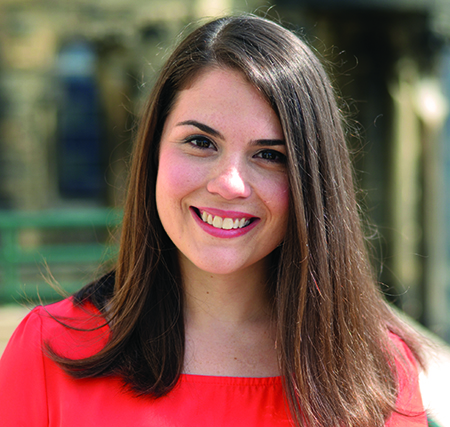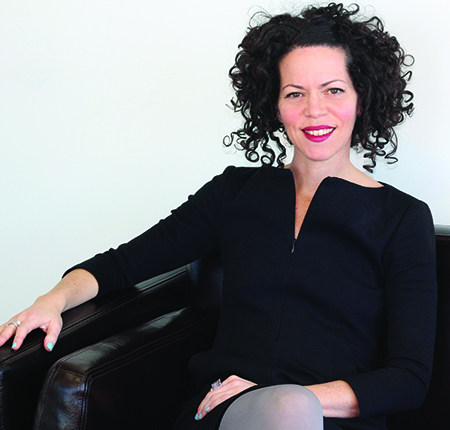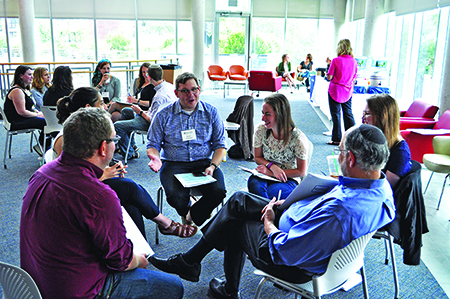American View
Feature
Being Jewish
Feature
In Search of a New Generation of Jewish Leaders

When Sheila Katz began thinking during college about how to turn her passion for education and Jewish life into a career, she couldn’t help notice that Jewish institutions didn’t seem to offer much promise to young women. The senior leaders all seemed to be men.
After graduating, Katz went to work as an elementary school teacher in the Teach for America program. But after two years, her old Hillel director at Ithaca College persuaded her to apply for a job with the Jewish campus group, and she landed a position in 2007 as program director at North Carolina Hillel, which reaches university and college campuses across the southern state.
It was there that she met Kathy Manning, the first woman to chair the nation’s largest Jewish charitable network, the Jewish Federations of North America. They connected through Manning’s husband, Randall Kaplan, who was chairman of the boards of both Hillel International and the University of North Carolina at Greensboro.
“I had lunch with Kathy and I had an ‘aha moment’ that I could do that,” Katz recalled. “I suddenly realized there are Jewish women out there running things.”
Now 32, Katz occupies one of the top posts at Hillel International: vice president for social entrepreneurship, a position created for her in early 2014 that made her Hillel’s youngest-ever vice president. Her hire, along with those of several other female vice presidents, highlights a remarkable shift for an organization that, until a few years ago, had only a handful of women in senior positions during its 90-year history. Now women comprise roughly half the vice presidents at Hillel, which is led by Eric Fingerhut, a former congressman. “Eric understood that for Hillel to thrive, he needed diverse people with diverse backgrounds guiding the organization,” Katz said. “Most Hillel directors 10 years ago were rabbis and men and older. Now we have people leading who are women, openly gay, not Jewish, have disabilities, millennials.”
Hillel’s growing diversity is one sign of how Jewish institutions are beginning to grapple with the changes sweeping Jewish life in America, and what those changes mean for the future of community leadership.
Jewish affiliation is falling, particularly among younger Jews. Those born after 1980 are less likely than previous generations to join synagogues, contribute to federation campaigns or affiliate with Jewish organizations, according to surveys by the Pew Research Center and others. Partly, that’s because younger Americans tend not to affiliate in general—with religion, political parties or other institutions.
The nature of community is changing, too. Increasingly, organizing and community-making take place online. Younger Jews who do engage in Jewish life tend to eschew joining legacy organizations and prefer newer, niche-oriented groups—such as the environmental group Hazon, the LGBTQ advocacy group Keshet and the pro-Israel StandWithUS.

Insofar as they’re interested in organized religious life, this generation prefers independent minyans like Kehilat Hadar in New York City, IKAR in Los Angeles or Mishkan Chicago over established synagogues.
Many younger Jews don’t feel the same need or the same gravitational pull to identify or be a member of a single institution,” said Stosh Cotler, 48, CEO of Bend the Arc, a Jewish group focused on domestic economic and social justice issues. “American Jews are asking themselves: Why be Jewish in 21st-century America? Why should we at any age be participating in Jewish life? What does the Jewish community stand for?”
Cotler appreciates that Bend the Arc doesn’t require her to compromise on any of the ways she identifies herself: woman, queer, Jewish, social activist. “Many of the Jewish communal institutions right now that are struggling with membership or affiliation or identity were developed at a different time in Jewish American history,” she said. “Now they need to articulate their current purpose, given that reality for Jews has changed quite dramatically.”
Shifra Bronznick, a longtime activist for women’s advancement in the Jewish professional field, agrees. “Lots of people feel they don’t have to work through these organized structures to contribute to the Jewish community; they can do their own thing,” she said. “The organized Jewish world is in decline partly because there’s so much more competition in terms of people’s attention.”
Meanwhile, American Jewish connections are also undergoing dramatic change. More than 70 percent of non-Orthodox Jews marry outside the faith, and an increasing number of intermarried couples raise their children as Jews. The fastest-growing segment among Americans in general is “the nones”—people, including Jews, who don’t identify with any particular religious affiliation, according to Pew. And American Jewry’s relationship to Israel is shifting, with criticism of Israel increasingly commonplace.
Against this backdrop, what does it mean to be a Jewish leader today? “It’s a much more complicated portrait than it once was,” said Jonathan Sarna, the Joseph H. and Belle R. Braun Professor of American Jewish History at Brandeis University in Massachusetts and chair of its Hornstein Jewish Professional Leadership Program.
“Leaders are known by their followers. So if you belong to an organization, you know who leads that organization. But the days when we had an organized Jewish community are clearly behind us,” he said. “A fragmented community means different groups look to different kinds of leaders. And those who are on the periphery of the community, belonging to no organizations—and Pew reminds us that there are a lot of such people—they hardly know who any of the leaders are.”
The question of what makes an American Jewish leader has never been easy to answer. In contrast with Europe, where Jewish communities have official representative bodies and formal leaders, American Jewish leadership always has been more dispersed and subjective. Ask young Jews who they look up to and they may be as likely to cite an inspirational figure who happens to be Jewish—Facebook founder Mark Zuckerberg, Supreme Court Justice Ruth Bader Ginsburg, Sen. Bernie Sanders of Vermont—as a rabbi or the head of a Jewish institution.

But there is a difference between a leader who happens to be Jewish, like Zuckerberg, and Jewish leaders—those who have chosen either in a professional or lay capacity to lead within the community, whether as a rabbi, activist, institutional leader or funder.
Amid all this flux, the organized Jewish world is poised to undergo a sea change. Over the next five to seven years, studies indicate, an estimated 75 to 90 percent of the nation’s roughly 10,000 Jewish organizations—including about 3,000 synagogues and hundreds of JCCs—will require new leaders. The many baby boomers who lead institutions will be retiring, and it’s not clear who will take their place.
For the vast majority of these institutions, which see themselves as critical to perpetuating vibrant Jewish life, closing down is inconceivable. On the contrary, given the challenge of getting younger people interested in Jewish life, they see their success—and the need for able administrators—as more critical than ever.
At the same time, there is a growing crop of relatively new, small Jewish groups narrowly focused on particular areas. One such group is Urban Adamah. Founded in 2010 in California, the group runs a farming fellowship, a summer camp program and various farm-based programs in the San Francisco Bay area.
“Urban Adamah emerged in response to a general trend and desire, particularly among young people, to experience an approach to Judaism that was connected to their social justice and environmental identities,” said founder and executive director Adam Berman, 45. “Jewish organizations are being asked to provide greater depth, meaning and joy in order to be relevant.”
Rabbi Elka Abrahamson agrees. “The Jewish world has become more boutique-oriented in the way it services the Jewish community,” said the president of the Wexner Foundation, one of several institutions trying to bolster the pipeline of future Jewish leaders.
“All kinds of Jewish organizations are popping up on the margins, and the mainstream is having to change what it does,” she noted. “Thirty years ago when we started, there were four rabbinical schools. Now we have applicants to our Wexner graduate fellowship program from eight or more institutions that ordain rabbis.
“We really embrace the notion that a leader is not a person, but leadership is an activity,” Abrahamson said.
Long considered an incubator of elite talent, Wexner runs programs to help prospective lay and professional leaders fine-tune their leadership skills, teaching them how to network and communicate effectively as well as foster innovation and adapt to evolving challenges.
While Jewish leadership programs are not new, they have proliferated in recent years, and many long-running ones have shifted focus from providing social work-type skills to cultivating business skills.

At the Hornstein Jewish Professional Leadership Program, for example, most students now graduate with an MBA. Once, a master’s degree in Jewish professional leadership was considered sufficient. Sarna, program chair, said Hornstein’s curriculum was revised to reflect the desire for business expertise by executives on the boards of nonprofits who believe business acumen is crucial to running a successful organization.
In 2014, a group of 17 major Jewish funders, alarmed by the difficulty they encountered finding people for senior positions in Jewish groups they support, pooled their resources to create a new organization to cultivate talent, train board members to be better lay leaders and help Jewish institutions become more professional and family-friendly places to work. The organization, Leading Edge: Alliance for Excellence in Jewish Leadership, based in New York City, recently inaugurated its first CEO Onboarding program to help new executives at Jewish nonprofits ease into their new roles. “We have to do a better job of preparing talent to take on substantive leadership positions,” said Gali Cooks, 38, the program’s executive director.
The Hadassah Foundation, too, is investing in leadership development. The foundation, which supports programs for girls and women, funds a curriculum at the Shalom Hartman Institute of North America that facilitates study among graduate students in Jewish professional leadership programs around the question of what ethical Jewish leadership means for the 21st century. The program, Created Equal, which so far has one cohort of nine graduate students from around the United States, consists of five two-hour online classes and a daylong, in-person conference in Manhattan. A focal point of the curriculum is gender equity. (Though women comprise roughly two-thirds of the Jewish professional sector, they occupy only about 30 percent of senior executive positions, according to a Leading Edge survey. In 2014, 12 of 71 major Jewish organizations were led by women, according to the Forward newspaper. At least two women have left their positions since then.)
Using Jewish texts, the Created Equal program explores how leaders should act and how to treat leaders with this overlay of gender, said Rabbi Ellen Flax, director of the Hadassah Foundation. “There are certainly many capable women who staff federations and other Jewish organizations at high levels. But at the same time, there clearly is a glass ceiling or a perception about the capabilities of women or prejudice against hiring women. Women don’t have the level of top leadership positions you’d expect them to have.”
Hadassah, the Women’s Zionist Organization of America also has long been concerned with cultivating a new generation of leadership. Its current two-year, part-time Hadassah Leadership Fellows program includes an orientation in New York City, a trip to Israel focused on social responsibility initiatives, leadership development training and a lobbying boot camp in Washington, D.C. In the second year, participants are expected to match their passions with their skill sets in a volunteer capacity with Hadassah. Twenty-four people have completed the course and 16 are now in the program.
The challenge of cultivating the next generation of leaders goes beyond training. Jewish institutions need to adapt, too, if they are to compete for top talent, experts say. That means everything from instituting more family-friendly leave and workplace policies to giving Jewish community professionals opportunities for advancement.
Leading Edge’s latest survey, released in September, polled 3,422 employees at 55 Jewish organizations. It found that while a vast majority of respondents feel connected to their workplace mission and respected and empowered at work, only about half see themselves staying in the field five or more years. About one-third plan to leave their organization within two years.
“We’re great at creating exciting work for people to do, but we don’t have the training, the right support or the right culture in place to convince them to stay,” said Mimi Kravetz, 37, who last year left her job in human resources at Google to become Hillel’s first chief talent officer. “Sometimes I think that the best people move out of the sector.”
On the flip side, when it comes to top spots in large Jewish organizations, boards appear more interested in hiring CEOs from the outside than insiders who have risen through the ranks. That is not very encouraging for aspiring leaders already in Jewish fields, Kravetz observed.
In the last year or two, the longtime heads of the Anti-Defamation League, the country’s largest Jewish federation and the American Jewish Joint Distribution Committee left, and each was replaced by men who made their careers outside Jewish organizations. UJA-Federation of New York is now led by a career lawyer, Eric Goldstein; the ADL position was assumed by Jonathan Greenblatt, an entrepreneur and former special assistant to President Obama; and the JDC’s incoming CEO is David Schizer, a longtime dean at Columbia Law School in New York.
The reason boards favor outsiders is because they are looking for business skills and fundraising potential—increasingly the most important determinants of an organization’s success, experts say. “You need the support of the philanthropic community to flourish as an organization,” said Chip Edelsberg, executive director of the Jim Joseph Foundation, which has given away about $400 million to Jewish causes since its founding 10 years ago. “Executing on a vision in a way that gets your funders to endorse the leadership you are providing is crucial to success.”
At the same time, many de facto Jewish leaders have emerged by dint of their own wealth. The Jewish world is not a democracy; big funders play an outsized role in setting agendas—and commanding attention. Sheldon Adelson, the casino magnate, has used his wealth to become a major power player in the Jewish world and beyond. Aside from his spending on conservative political causes, Adelson owns multiple Israeli news outlets, and he funds sizable portions of Birthright Israel, the Republican Jewish Coalition, the Israeli American Council and the Jerusalem Center for Public Affairs. Likewise, Ronald Lauder, the cosmetics heir and World Jewish Congress president, has used his philanthropy to claim a leading role in Jewish life both via the WJC and by reinvigorating European Jewish life through his family foundation.
There is nothing wrong with wealth helping pave a path to Jewish leadership, said Malcolm Hoenlein, executive vice chairman of the Conference of Presidents of Major American Jewish Organizations, an umbrella group of national Jewish agencies. “You make a lot of money and you donate and you can become a Jewish leader. I think those people should be really celebrated for what they do,” Hoenlein said. “They are people whose names open doors, who facilitate our effectiveness by virtue of their standing. We should do everything to encourage it.”
The importance of fundraising is one good reason emerging leaders within Jewish organizations should be given opportunities to build relationships with board funders, Jewish professionals say.
Jennifer Gorovitz, 52, who in 2010 became the first woman to head a big-city Jewish federation, in San Francisco, said she succeeded only because she had such access. Once she was CEO, she said, she had board support to help ensure her success.
Gorovitz, who moved to the New Israel Fund in late 2015 and is now a vice president there, thinks the big challenge Jewish institutions must tackle now is adapting to a rapidly changing American Jewish landscape. “Institutions are going to have to get out and do a lot of talking with the next generations of young people and really find out what they need and want from our institutions,” she said.
“What are the things that are going to sustain them spiritually, emotionally, from a service perspective, from a leadership perspective and in terms of their relationship with Israel?” she said. “We have to invest a considerable amount of time and resources to ask these questions because otherwise we’re going to get caught flat-footed.”








 Facebook
Facebook Instagram
Instagram Twitter
Twitter
Connie Hinitz says
As a long-time Cincinnatian, I recall the admonition of Jacob Rader Marcus (z”l), Professor of American Jewish History at Hebrew Union College. He recommended avoiding the use of the word “first” when describing historical phenomena because someone will always find an earlier example.
I thought of Dr. Marcus when I read this important article because of an error contained therein. The first female to head the national network of Jewish Federations was Shoshana Cardin. She was elected president in 1984 of what was then known as the Council of Jewish Federations.
What is unfortunate is that more than 25 years passed before another female became the chief volunteer officer of this very important organization.
Bill Robinson says
As the Dean of the pluralistic Davidson School at JTS, I am pleased to see Hadassah promoting this critical issue. Investing more in identifying, recruiting, and retaining the next generation of Jewish professional leadership should be among our top priorities as we seek to secure an even stronger Jewish future. We have been training the next generation of leaders for the past 20 years. We are proud of our 1000 alumni who work across denominations and boundaries, reinvigorating legacy organizations and building start-ups – from Betzy Lynch, E. D., of the Levite JCC of Birmingham to Yoni Stadlin, founder of Eden Village Camp in Long Island – in over 50 communities throughout North America. Last year, we brought together our various leadership institutes to form THE LEADERSHIP COMMONS, which cultivates talented thinkers, doers, and visionaries from all corners of the Jewish world to shape the Jewish future together for the common good. We are partnering with national organizations and communal foundations to take on this vital challenge, because we will only succeed if we work together.